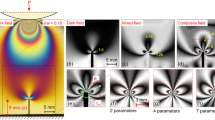Abstract
This paper deals with the identification of elasto-plastic constitutive parameters from deformation fields measured over the surface of thin flat specimens with the grid method. The approach for recovering the constitutive parameters is the virtual fields method. A dedicated algorithm is used for deriving the distribution of the 2D stress components from the measured deformation fields. A state of plane stress is assumed. Guesses of the constitutive parameters are input in the algorithm and updated until the stresses satisfy the principle of virtual work in the least squares sense. The advantage of this approach is that it can handle very heterogeneous plastic flows and it is much faster than classical finite element model updating approaches. An experimental application is provided to demonstrate it. Six mild steel double-notched specimens have been tested in a configuration combining tension and in-plane bending. The identified parameters are in good agreement with their reference counterparts. Stress fields are eventually reconstructed across the specimen all along the test for analyzing the evolution of the plastic flow.
Similar content being viewed by others
References
Laws V (1981) Derivation of the tensile stress-strain curve from bending data. J Mater Sci 16:1299–1304.
Mayville RA, Finnie I (1982) Uniaxial stress-strain curves from a bending test. Exp Mech 22:197–201.
Brunet M, Morestin F, Godereaux S (2001) Nonlinear kinematic hardening identification for anisotropic sheet metals with bending-unbending tests. J Eng Mater Technol 123:378–383
Zhao KM (2004) Inverse estimation of material properties for sheet metals. Commun Numer Methods Eng 20:105–118
Mahnken R, Stein E (1994) The identification of parameters for visco-plastic models via finite-elements methods and gradient methods. Model Simulation Mater Sci Eng 2:597–616
Mahnken R, Stein E (1996) A unified approach for parameter identification of inelastic material models in the frame of the finite element method. Comput Methods Appl Mech Eng 136:225–258
Meuwissen MHH (1998) An inverse method for the mechanical characterisation of metals. PhD thesis, Eindhoven Technical University.
Meuwissen MHH, Oomens CWJ, Baaijens FPT, Petterson R, Janssen JD (1998) Determination of the elasto-plastic properties of aluminium using a mixed numerical-experimental method. J Mater Process Technol 75:204–211.
Okada H, Fukui Y, Kumazawa N (1999) An inverse analysis determining the elastic-plastic stress-strain relationship using nonlinear sensitivities. Comput Model Simulation Eng 4(3):176–185.
Hoc T, Crépin J, Gélébart L, Zaoui A (2003) A procedure for identifying the plastic behaviour of single crystals from the local response of polycrystals. Acta Materialia 51:5477–5488.
Kajberg J, Lindkvist G (2004) Characterization of materials subjected to large strains by inverse modelling based on in-plane displacement fields. Int J Solids Struct 41:3439–3459.
Cooreman S, Lecompte D, Sol H, Vantomme J, Debruyne D (2007) Elasto-plastic material parameter identification by inverse methods: Calculation of the sensitivity matrix. Int J Solids Struct 44(13):4329–4341.
Geng L, Shen Y, Wagoner RH (2002) Anisotropic hardening equations derived from reverse-bend testing. Int J Plasticity 18(5-6):743–767.
Grédiac M, Pierron F (2006) Applying the virtual field method to the identification of elasto-plastic constitutive parameters. Int J Plasticity 22(4):602–627.
Grédiac M, Pierron F, Avril S, Toussaint E (2006) The virtual fields method for extractiong constitutive parameters from full-field measurements: a review. Strain 42:233–253.
Pannier Y, Avril S, Rotinat R, Pierron R (2006) Identification of elasto-plastic constitutive parameters from statically undetermined tests using the virtual fields method. Exp Mech 46(6):735–755.
Sutton MA, Deng X, Liu J, Yang L (1996) Determination of elastic–plastic stresses and strains from measured surface strain data. Exp Mech 36(2):99–112.
Lemaître J, Chaboche J-L (1990) Mechanics of solid materials. Cambridge University Press, Cambridge, UK.
Grédiac M, Toussaint E, Pierron F (2002) Special virtual fields for the direct determination of material parameters with the virtual fields method. 1–Principle and definition. Int J Solids Struct 39(10):2691–2705.
Grédiac M, Toussaint E, Pierron F (2002) Special virtual fields for the direct determination of material parameters with the virtual fields method. 2–Application to in-plane properties. Int J Solids Struct 39(10):2707–2730.
Chapelle D, Darrieulat M (2003) The occurence of shear banding in a millimeter scale (123)[634] grain of an al-4.5% Mg alloy during plane strain compression. Mater Sci Eng A 347(1-2):32–41.
Avril S, Pierron F (2007) General framework for the identification of constitutive parameters from full-field measurements in linear elasticity. Int J Solids Struct 44(14-15):4978–5002.
Avril S, Grédiac M, Pierron F (2004) Sensitivity of the virtual fields method to noisy data. Comput Mech 34(6):439–452.
Feng Z, Rowlands RE (1991) Smoothing finite-element and experimental hybrid technique for stress analyzing composites. Computer Struct 6:631–639.
Piro J-L, Grédiac M (2004) Producing and transferring low-spatial-frequency grids for measuring displacement fields with moiré and grid methods. Experimental Techniques 28(4):23–26.
Surrel Y (1996) Design of algorithms for phase measurements by the use of phase-stepping. Appl Optic 35(1):51–60.
Avril S, Pierron F, Yan J, Sutton M (2007) Identification of strain-rate sensitivity with the virtual fields method. In: Gdoutos E (ed) Proceedings of ICEM13, Alexandoupolis, Greece.
Author information
Authors and Affiliations
Corresponding author
Rights and permissions
About this article
Cite this article
Avril, S., Pierron, F., Pannier, Y. et al. Stress Reconstruction and Constitutive Parameter Identification in Plane-Stress Elasto-plastic Problems Using Surface Measurements of Deformation Fields. Exp Mech 48, 403–419 (2008). https://doi.org/10.1007/s11340-007-9084-2
Received:
Accepted:
Published:
Issue Date:
DOI: https://doi.org/10.1007/s11340-007-9084-2




